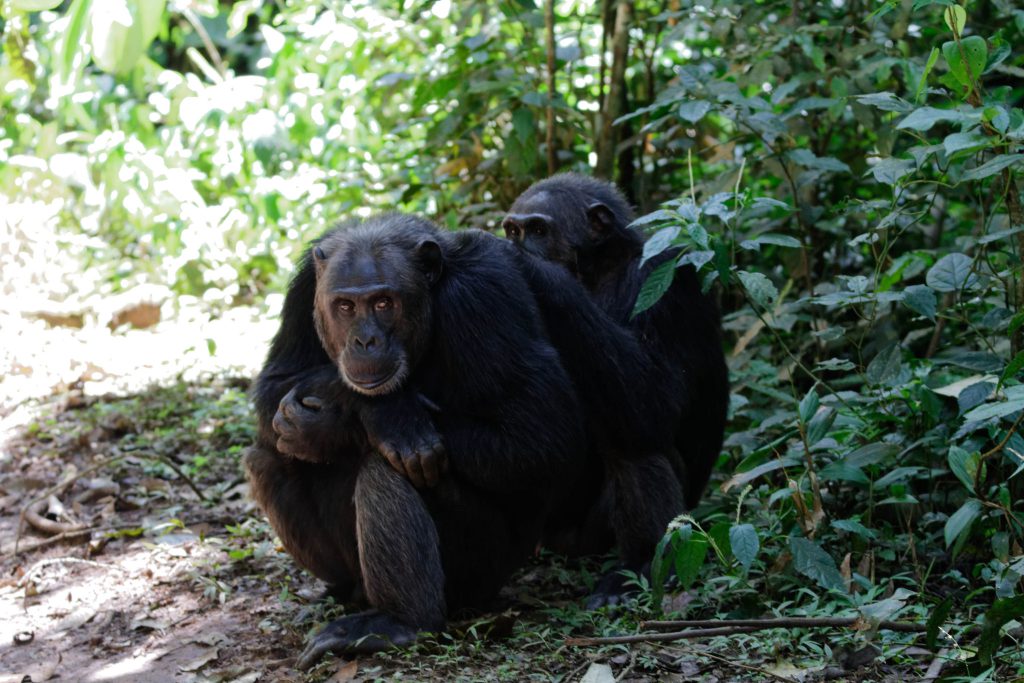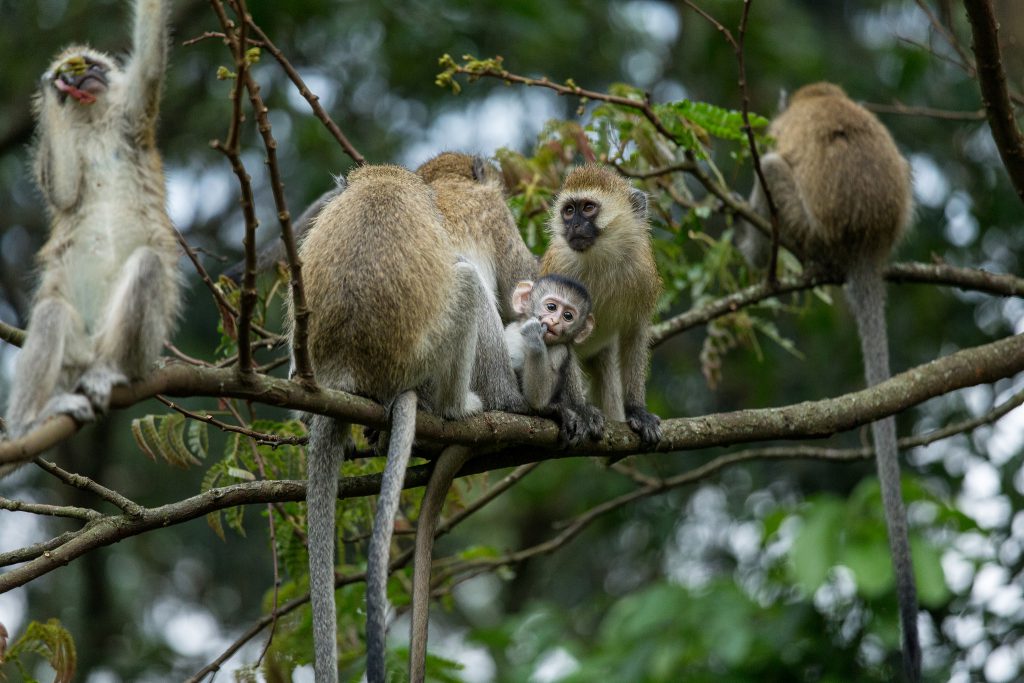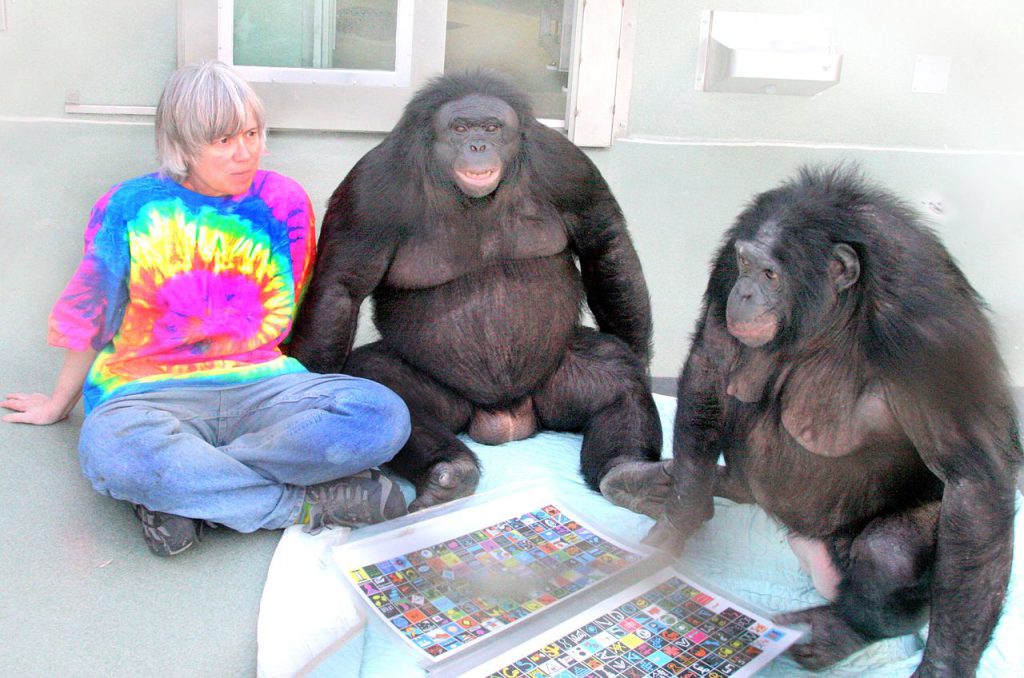Primate Vocalizations Are Much More Than Gibberish

A chimpanzee is strolling along a trail through the lush Budongo Forest in Uganda when he spots a deadly Gaboon viper. Chimps have an alarm call for scenarios like these: a soft “hoo” grunt that alerts others to potential danger. But there’s no point in alerting his group mates if they’re already aware of the threat. So what does he do?
This is the question that Catherine Crockford, a primatologist at the Max Planck Institute for Evolutionary Anthropology, and her colleagues were keen to answer. They are the ones who’d put the viper—a convincing model made out of wire mesh and plaster—in the chimp’s path. It sounds like a silly prank, trying to surprise a chimp with a model snake. But the researchers were trying to get at an elusive and profound question: How much of what a chimp “says” is intentional communication?
Their findings, published in 2012, along with those of a 2013 follow-up study by University of York psychologist Katie Slocombe and colleagues, challenged long-held assumptions about what makes humans unique among our primate relatives.
Researchers have spent decades endeavoring to unravel the depth of communication that nonhuman primates can achieve. Do they have words as we would think of them? Do they have grammar? Since language is so integral to our identity as humans, these questions get to the heart of what it means to be human. While the public tends to imbue every cat meow and dog bark with meaning, scientists have traditionally taken a much more conservative approach, favoring the least cognitive explanations and assuming that animal vocalizations are involuntary and emotional. “Conservatism is essential if animal cognition work is to be taken seriously,” says Slocombe.
We can’t see inside primate brains (at least not without a lot of practical and ethical difficulty), or ask primates what they mean or why they vocalize. So primate-communication researchers have been forced to devise clever studies to work out what’s going on in their subjects’ minds.
It was already known by the 1960s that vervet monkeys (a primate species native to Eastern Africa) have several distinct alarm calls, each associated with a different type of predator: leopards, eagles, and snakes. The monkeys also show specific avoidance behaviors for each predator: In the presence of a leopard they run up into the trees, while eagles elicit the opposite reaction; when a snake appears, vervet monkeys stand on their hind legs and scan the ground. But whether vervets’ alarm calls facilitate these avoidance behaviors was unknown: Do these vocalizations actually function like words—“leopard,” “eagle,” “snake”—carrying meaning to those who hear them? Or are they meaningless emotional outbursts, simply sounding different because the three predators strike slightly different emotions in the monkeys?
For over a decade, in keeping with a tradition of conservatism and skepticism about animal cognition, most researchers assumed the latter. They attributed the vervets’ specific anti-predator behaviors to the presence of the predator rather than to the alarm call.
Then came a seminal 1980 study: Animal behaviorists Robert Seyfarth, Dorothy Cheney, and Peter Marler, then at Rockefeller University, placed a speaker out of sight and broadcast different alarm calls to a troop of vervet monkeys. The monkeys had predator-specific reactions to the different calls, even though there were no real predators around. Clearly, they were reacting to the call itself.
This study revolutionized the field. In the time since, experiments have investigated calls relating to specific predators, foods, and social happenings across more than a dozen primate species. But these findings still don’t get at what the calls mean to those who hear them: Upon hearing a leopard alarm call, does a monkey run into a tree because it imagines a scary leopard armed with sharp teeth and claws? Or is it simply because the specific sound of the call triggers a specific nervous system reaction, like how we might involuntarily cringe at the sound of nails on a chalkboard?
In 1999, Seyfarth and Cheney, along with University of St. Andrews psychologist Klaus Zuberbühler (who also worked with Crockford, Slocombe, and others on the chimpanzee studies), addressed this question with Diana monkeys, a forest-dwelling primate native to western Africa with a similar alarm-call system to vervets. It was known that when a monkey hears more and more alarm calls in a short period of time, it becomes used to the calls (or “habituated”) and stops reacting—sort of a boy-who-cried-wolf response. But what exactly is the monkey becoming used to: the sound of the call or the idea of a leopard?
To get at this, the researchers first habituated Diana monkeys to a leopard alarm call—then they played an actual leopard’s growl and watched how the monkeys responded. The monkeys showed a highly dulled reaction to the leopard growl. The researchers also played leopard alarm calls followed by eagle shrieks instead of leopard growls; in that condition, the monkeys reacted strongly to the eagle shriek despite being habituated to the leopard alarm. The best interpretation is that the leopard alarm call means “leopard.” Whenever a monkey hears this call, it thinks of a leopard and runs up a tree; as it hears more calls in a short period of time, that thought becomes less provocative, to the point that even hearing the sound of a real leopard no longer elicits a reaction. But they’ll remain sensitive to eagles, because monkeys think of these two predators as separate, distinct threats.
For vervets, Diana monkeys, and other primate species, it’s clear that calls do carry meaning for those who hear them—a characteristic that was once thought to be unique to human communication. Until recently, all these results were interpreted as clear evidence of human-like communication in primates—perhaps even an evolutionary precursor to human language. In the last decade, however, researchers such as Cheney and Seyfarth have pulled back a little, noting all the possible differences between primate communication and human language. For example, the mental processes monkeys use to interpret alarm calls may be much simpler than how humans interpret words. Perhaps, these researchers caution, thinking of monkey vocalizations as analogous to words is too presumptuous.
Another important aspect of human language is that it’s usually intentional: The speaker has a desire to communicate something to the receiver. Critically, the fact that monkey calls carry meaning for listeners still doesn’t tell us anything about what’s going on in the minds of those making the calls: Do they understand the meaning and use the calls intentionally in a manner similar to the way we use language? Or are primate vocalizations more like some human screams or laughter: potentially meaningful to listeners—we might infer the presence of danger from a scream—but not intentionally so?
Tackling this question is more complicated than one might think. For example, many animals, even chickens, show “audience effects”—that is, they are more likely to call if others are nearby. But this alone is not considered sufficient evidence for intentional communication because it could be that the presence of others simply changes the emotional state of the caller, perhaps just making them more excited and therefore more likely to call out. True evidence of intentional communication requires showing that a caller changes its vocal behavior based not only on whether others are within earshot but also on whether or not the listeners are already aware of the relevant information.
Until recently, such evidence for intentional vocal communication in primates was weak—for example, macaque mothers are no more likely to call out to their infants about food when the infant is unaware than when it has already seen the food. But the question had never been directly tested with an ape.
This brings us back to the 2012 snake study carried out by Crockford, Max Planck Institute primatologist Roman Wittig, and colleagues.
Over and over, assumptions about the limited communicative abilities of nonhuman primates have been overturned.
While lurking nearby, the researchers waited for two or more chimps to arrive at the location of the fake snake, carefully watching to see who spotted it and who didn’t. They found that chimps who noticed the viper were significantly more likely to utter a “hoo” call if the other chimps had missed the threat. And they were less likely to call if they had heard a distant chimp’s “hoos” in the area earlier on, probably assuming that the listener or listeners had inferred the presence of the threat from the earlier calls. It seems the callers were intentionally trying to inform listeners of potential danger. Further, the chimps made more calls to listeners with whom they shared a strong social bond; they seem to have been more motivated to ensure that their close friends or relatives were aware of the threat.
Chimpanzee gestures, such as an arm raise or a stomp of the foot, were previously thought to be used intentionally (for example, to get another’s attention). But the viper study provided the first strong evidence of intentionality in a vocalization. So this study made a sizeable splash, even receiving praise from Seyfarth and Cheney, adherents to the traditional anti-intentionality view. Then Slocombe and colleagues took the idea even further.
In their 2013 follow-up study, Slocombe and her colleagues, including lead author Anne Marijke Schel, an ecologist at Utrecht University in the Netherlands, also surprised chimps walking along a path by presenting them with a model snake. In this experiment, the researchers looked at the chimps’ behavior in greater depth. They found that a “hooing” chimp would look back and forth between his partner and the snake, checking whether his partner had seen it or not, and would stop as soon as the partner became aware of the potential danger. This was yet more evidence for intentionality.
This line of research isn’t over, says Crockford—the studies need to be replicated and tested under different conditions to firm them up. “Replicating results is fundamental to good scientific practice. … So there is still more work to be done,” she says. Her team has already begun testing other primate species in the same way.
While it’s clear that there is strong evidence of meaning as well as intentionality in certain primate vocalizations, a key question remains: Do primates have anything like the complex grammar and syntax systems present in human language?
Some primate species show a sort of rudimentary grammar: Campbell’s monkeys (a species closely related to Diana monkeys) can modify the urgency and specificity of their alarm calls by combining them with separate calls or by adding a suffix. In this species, “krak” is for leopards, and “boom” is for disturbances like falling branches; “boom-boom-krak” signifies a far-off leopard (no immediate need to escape, but keep an eye on it), and “krak-oo” is a general alert call. But this is nowhere near the complexity of human language.
Apes are more intelligent than monkeys, and their communication tends to be more fluid—they use the same vocalizations in many different contexts, for example. This makes apes interesting study subjects, but it also means it’s harder for researchers to determine the significance of their vocalizations.
Some apes in captivity have been trained to communicate using sign language or printed symbols called lexigrams. The most impressive example is Kanzi the bonobo, who lives at the Ape Cognition and Conservation Initiative (formerly the Great Ape Trust) in Des Moines, Iowa. Kanzi learned to communicate by pointing to lexigrams on a large board, through training by Sue Savage-Rumbaugh, and by watching his lexigram-trained adoptive mother, Matata. Kanzi also understands some spoken English and can carry out fairly complex requests like “would you please pour the Perrier water in the jelly?,” without having been exposed to the relevant words (“Perrier water” and “jelly”) together before.
Some researchers argue that language-trained apes like Kanzi are motivated entirely by rewards rather than a genuine desire to exchange information with humans (only a small minority of Kanzi’s communications are commentary—most are requests for something, usually social play), and they question whether apes understand the communicative nature of language at all. Either way, Kanzi’s language production pales in comparison to that of the average human. He, like other language-trained apes, produces “sentences” consisting of only a few symbols: Rather than communicating “would you like to play tickle or with the ball,” he might signify something like “tickle ball.” And Kanzi produces those symbols in a seemingly random order. Though he understands the difference between “pour the water in the jelly” and “pour the jelly in the water” when he hears those sentences spoken by a human experimenter, he doesn’t seem to grasp the importance of word order in his own lexigram usage.
But is this because apes lack the ability to learn syntactic rules, or simply because they’re not cut out for human language? Gibbon song may provide an example of syntax in an ape’s natural communication system. Gibbons (small Southeast Asian tree swingers at the base of the ape evolutionary tree) construct complex “songs” from syllables called “song elements.” Whereas many monkeys convey information about potential predators with a single, one-syllable call, gibbons do so by stringing together song elements into sequences. In gibbon song, as in human language, a single syllable isn’t enough to convey much; meaning arises from the way syllables are strung together. At the moment, however, we have no idea how complex or simple gibbon song truly is, and we have no reason to assume that it’s anything like human language.
Perhaps it is our systems of grammar and syntax that distinguish human language. But these aren’t the first attributes that have been thought to make us unique. Over and over, assumptions about the limited communicative abilities of nonhuman primates have been overturned. As Slocombe points out, “absence of evidence does not mean absence of ability”—just because studies haven’t revealed complex primate grammar doesn’t mean it isn’t there. Who knows what remains to be discovered in the vocalizations of primates—particularly apes, whose vocal communication is still poorly understood.



























